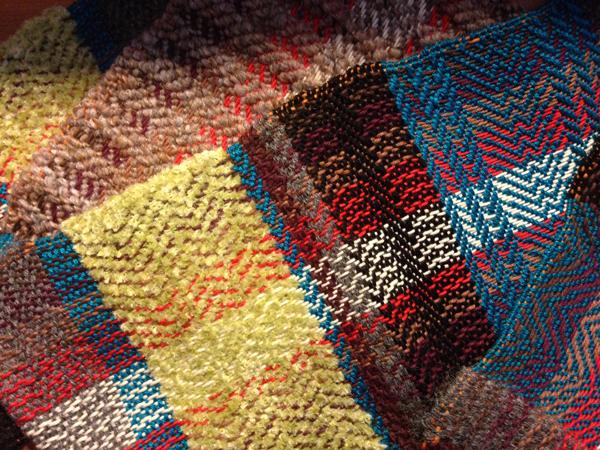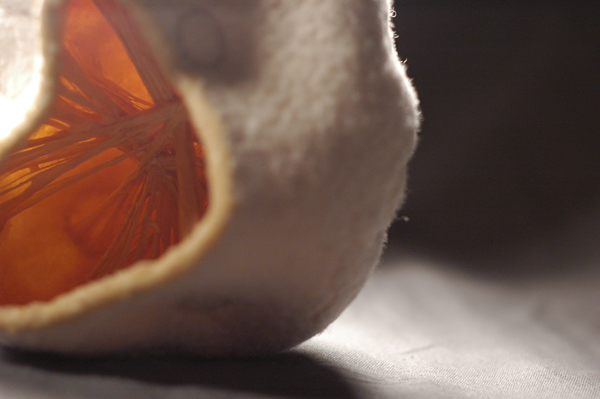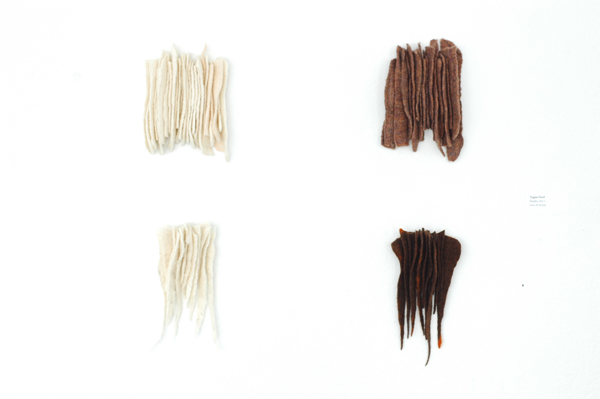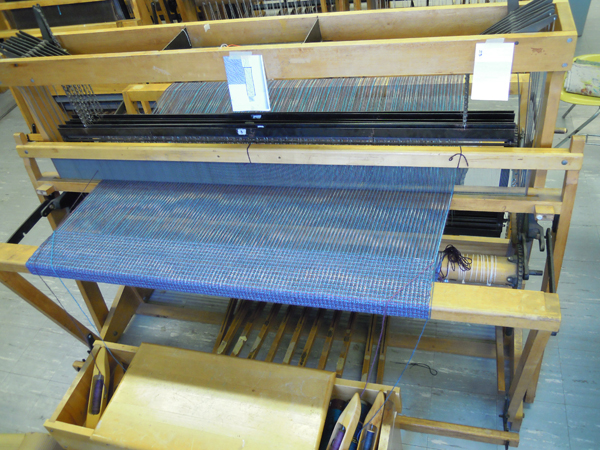I often get asked "how did you become a weaver?"
This conversation usually is a long and wonderful story. However, I do not really get a chance to tell the whole story due to situational circumstances (ie. talking in the elevator with a box full of weavings).
So, here, on this blog, is the full story! (It is long, but each part is important to know)
My family tree is full of people who use their hands to create. My paternal grandfather always kept his hands busy. He created bird houses, flies for fishing, and in his younger years built houses and snow shoes. He was a mountain man and a farmer, if it was broken, he would fix it. My paternal grandmother was a quilter and a seamstress. Not only did she create beautiful textiles, she also used her mind to research our family history, tracing it back to those who immigrated from England. One of my fondest memories is sitting down at her sewing table and working from start to finish all day to create a blue jumper on her sewing machine with her. I walked upstairs wearing it and my grandfather looked at me and said "that is my favorite color blue." I wore that jumper for days afterward. My maternal grandmother was a chemist in her youth, and when she retired she spent her free time traveling and learning about new crafts and new cultures. She traveled to New Mexico and created beautiful ceramic pieces that were pit fired. Also, many of the gifts I received from her were meant to jumpstart my creativity. My very first loom were given to me by her- one was a bead loom and the other a frame loom. My maternal grandfather was a pharmacist, using his hands to create medicines to help members of his community.
My parents are both extremely creative people.
My mother is very compassionate about fine craftsmanship. She is a seamstress, a gardener and a collector of fine china and vintage linens. She taught me how to crochet and how to cast on for knitting. She brought weaving into the house. She took a tapestry weaving class and made purses and wall hangings, designing her patterns from her favorite china. She currently is working on a dye garden to dye tape for chair seat weaving.
My dad was a cabinetmaker. During his time as a "stay at home dad" he also created musical instruments, toys, and magic tricks from his wood work. His love of comic books also lead him to do some illustration and painting. One of my favorite things he ever made was a beautiful acoustic guitar with a celtic knot sound hole. He also knew how to sew and would create new outifts for his "Mr. Magic" magic show. Their creativity nurtured my siblings and I to explore all different avenues of the arts. My brother was passionate about illustration, my sister is working her way through a graphic design program and I- went into textiles.
With all of these influences around me, it makes sense that I was always working on something. I drew comics, painted, wrote poetry, played the flute, and I made things from bits of fabric and yarn. There are two major projects that stood out in my mind of things that encouraged me towards textiles. When I was seven years old, my mom asked me if I would like a quilt. What she had me do was draw everything that was important to me at the time. She then cut out my drawings and translated them out of fabric- using embroidery to eccentuate the smaller details of my drawings. It included a sewing needle and thread, a paint brush and pencil, one of our dogs, my hands and her hands. There were other things but those quilt blocks stood out to me. It was my "seven year old quilt" and looking back, was a really creative way to document what was truly important to me when I was little. The other project was my afghan. It started out as a baby blanket for a cousin that was going to be born- or a baby that was being adopted. I don't know. But somebody told me that the colors might be too dark for a baby, so I just started making it bigger and bigger for myself. I started it when I was 9 or 10 and I didn't finish the afghan until I was around 17. Whenever I had a little bit of yarn I would add to it, finally finishing it off towards the end of my high school career. I just combined colors and textures until it became this great source of warmth and comfort. It still is a prominent feature on my bed.
Towards the end of high school, people were getting accepted to college and I had a dream. My dream was to be a fashion designer. I connect that to the first season of Project Runway. I wanted to problem solve using fabric and making amazing things that people would wear. I applied to a school in New York City and thought for sure I would get in- I mean how hard could it be?
Well it was hard. During the portfolio review day I realized that I was poorly equipped for this type of judgement. I could write my way out of or into anything, but I could not show in quantitative measures that I had the skills to be part of their fashion design program. There was a test, and all I had brought with me was a ball point pen. (Other applicants brought Prisma Color Markers, Watercolors, and other handy artistic tools) We had to draw a model with an outfit for some occasion. I just drew what I thought was interesting. When I met one on one with one of the reviewers- she told me that based off of my images and my concepts- I wasn't really meant to be a fashion designer. My heart was smashed to bits. I was about to cry. She then paused, grabbed another professor, and they told me I would be an excellent candidate for the textiles program. My sketch during the test showed that I had a greater interest in the textures created by the fabric, than the actual construction of the garment itself. They invited me to apply the next year for that program.
I did not want to hear that. But I waited a year and applied again. Then changed my mind and went to a school where they would teach me the techniques I needed and wanted. I ended up in the fiber design program at Buffalo State College. I was so excited that I went full force into everything. The first semester I did dyeing, basic printing and weaving. Weaving was the last section we did, and my close friend in that class already knew how to weave, so I tried to keep up with her. Lesson learned: if you don't know how to do something, don't try to keep up with somebody who is practically an expert. Your results will be less than desirable.

We learned on table looms that first semester, and the second semester we graduated to the floor looms. I liked weaving but didn't think a whole lot about it. I was interested in more sculpturally acceptable media like felting, three dimensional embroidery and some knitting. Many of the projects that I worked on and submitted did not include any weaving what so ever. I would spend a good month or so each semester on a weaving project, but that was to keep practicing.

The semester before I graduated I put on a sculpture show with a close friend of mine. I produced a large weaving that I displayed on a pedestal like a sculpture. I had literally pulled it off the loom that morning and folded it neatly on the pedestal. One of my fiber professors came to the show and stopped me for a little bit. She asked "how long did it take you to weave that?" The piece was about 20-25" wide and over four yards long. I told her it took me four days to weave the entire thing. Her next question "why aren't you weaving more?" I gave her a long convoluted answer about how I didn't see the artistic integrity in weaving, and the sculpture spoke to me and that weaving was a means to an end... some ridiculous answer that an art student might use to deceive themselves against their true calling. She told me to really consider weaving, because I had a skill to understand a complicated process.


I had an artistic crisis.
Not only did a professor I respect tell me that my technical woven work was stronger then my fine craft work, I was starting to doubt my own capabilities. That Spring semester I was waiting with my husband outside one of his class rooms, talking about my senior thesis show. I felt as if I had nothing to show for the entire time that I had been at school. It was a whole hodge-podge of a little bit of everything. I wanted my Senior Show to really stand out and say to the world "this is who I am!" My ideas jumped around from making felt sculptures based off of the human body, doing something to do with screen printing, and I think at one point I wanted to do a big installation piece. My husband very point blank said "Well, why don't you weave?" Weave?! What was I going to make? I wanted to make big abstract art that had deep meaning and he wanted me to just weave?!
After a couple hours of really talking it out, I realized that weaving was probably the best choice for me. I had the technical ability to really produce fine weavings that hadn't been made before in the program, and that I didn't have to do anything crazy- just weave what I wanted and people would come.

That summer before my senior semester, I gained access to the weaving and dye studio and worked every day. I wove yardage and pieces that I felt were inventive. There were still some problems and I was running into some issues with my math and I didn't understand why everything I was making was not 100% perfect. I ended up deciding to take a class at Harrisville Designs with Tom Jipson to work out a few kinks in my weaving routine. I wove a sampler a day for a week.


It was an incredible experience to just go and work out ideas and pick someone's mind who weaves all the time. When I returned to school for that semester, my mistakes grew less frequent and I was focused more on exploring actual structures and uses of color then trying to make something big and grandiose.
That semester, I began to feel like a whole person again. I wasn't feeling so fragmented between all of my passions, and I was really digging my teeth into something that I could do- all the time. Overall, the show was a success. I sold out of almost all of my pieces from my senior thesis show. There were a few larger pieces that did not sell, but I am glad they didn't- because they are sort of my keystone pieces when I meet new clients.

Then school was over. I moved from down town Buffalo to an outlying suburb. And I started working full time at a retail job. I was weaving, just not as whole heartedly. I was having a little bit of a crisis of "how am I going to keep pushing myself?" I had broken from the bubble of academia only to get absorbed into a bubble of isolation. During that time my husband and I talked about really starting up a small business. And we decided that together we would work on a weaving business. I really wanted to weave full time, but nothing was selling and I was having a difficult time gaining any ground.
When we moved back to the Eastern part of the state, my weaving really became more of a career then a hobby. I became connected with a few people that needed weavings done, and I really started spending the time learning all the different techniques that I could. I try to follow through on my New Year's resolution: which was to weave every day. I am not at the loom every day, but I am working on weaving related projects every day. It took a long time to get to this point, and I am waiting for the day where I can do this full time, instead of segmenting my time between my day job and my dream job.
I started with a bead loom and frame loom, upgraded to school looms in college, bought a small four harness loom, then a 12 harness floor loom and now an AVL 16 harness loom and I am shopping for one more to fill out my equipment needs. As my passion for the craft grows, so does my need to learn more. I love weaving because I feel as if the path of knowledge is always growing and never ending.
That is how I became a weaver. A little bit of insight to my stubborn thinking turning into revelations.

How did you become a weaver? What made you decide to sit down at the loom and create cloth with your own hands? Are there any questions that I didn't answer about how I became a weaver? Feel free to ask, and answer back! I would love to hear your stories.